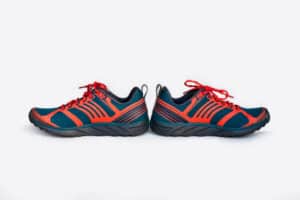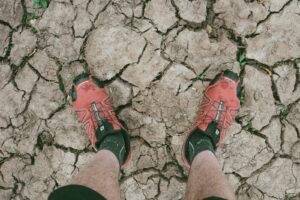Ready to explore rocky terrains, technical landscapes, and off-road adventures? Trail running’s a thrilling journey, beginning with selecting the perfect gear, especially trail running shoes. In this in-depth guide, we’ll walk you through how to choose trail running shoes tailored to your unique requirements, whether you’re an experienced trail runner or a novice.
Trail Running Shoes – The Foundation of Your Adventure
Trail running shoes are not just your typical running shoes. They are specially designed to tackle the challenges of uneven and unpredictable terrain. Choosing the right pair can make a world of difference in terms of comfort, performance, and even injury prevention. In this guide, we’ll break down the key factors to consider when selecting trail runners, ensuring you make an informed decision.
Understanding Your Trail Running Needs

To start your journey in choosing the perfect trail shoes, you must understand the specific demands of your running environment. Different terrains can have a significant impact on the type of shoes you require. Here are some crucial factors to consider:
1. Trail Types:
- Rocky Trails: If you often find yourself on rocky terrain, you’ll need a shoe with extra protection in the form of a rock plate or a rugged outsole.
- Technical Trails: For technical terrain, where you encounter steep inclines and declines, choose shoes with excellent traction and stability.
2. Foot Pronation:
- Your foot pronation, whether you have neutral feet, overpronate, or underpronate, affects the type of shoe support you need.
3. Cushioning and Support:
- Consider the level of cushioning required based on the terrain. More cushioning for soft terrain and less for rocky or technical trails.
4. Waterproof vs. Breathable Shoes:
- Think about the weather conditions in your running area. Waterproof shoes are great for wet environments, while breathable shoes are better in dry conditions.
Types of Trail Running Shoes

There are various types of trail running shoes available, and each serves a specific purpose. Let’s explore some common categories:
1. Low-Tops:
- These shoes offer a lightweight and flexible option for less technical trails.
2. Mid-Tops:
- Mid-top trail running shoes provide more ankle support and are ideal for rough terrains.
3. High-Tops:
- High-top shoes offer the most ankle support, making them suitable for challenging and technical trails.
Proper Fit and Sizing
Achieving the perfect fit is crucial for trail running shoes. Here are the steps to ensure you get the right size:
1. Measure Your Feet:
- Before you make a purchase, measure both your feet. Feet can vary in size, and it’s essential to accommodate the larger one.
2. Check Toe Box Space:
- Ensure your toes have adequate room in the toe box. A snug but not tight fit is ideal.
3. Try Before Buying:
- Whenever possible, visit a local store to try on shoes. It’s the best way to ensure you find the right fit.
Shoe Features to Look For
When it comes to trail running shoes, some features can greatly enhance your experience. Here’s what to consider:
1. Outsole Traction:
- The outsole should provide excellent grip and traction for your specific trail type.
2. Rock Plate:
- A rock plate in the sole can protect your feet from sharp rocks and debris.
3. Heel-to-Toe Drop:
- Consider the heel-to-toe drop, which can affect your running style. Lower drops are closer to a barefoot experience, while higher drops provide more cushioning.
4. Foot Protection:
- Some shoes offer additional protection in the form of reinforced toes and durable upper materials.
Brand and Budget Considerations

Selecting the right brand can also impact the quality and durability of your trail running shoes. Here are some reputable brands to consider:
1. Salomon:
- Known for their sense ride and sense series, Salomon offers a range of high-quality trail runners.
2. Altra:
- Altra’s Lone Peak series is popular among trail runners for its zero-drop platform and wide toe box.
3. Choosing the Best Trail Running Shoe:
- Sometimes, it’s not just about the brand but finding the shoe that best fits your unique foot shape and running style.
Maintenance and Longevity
To make your trail running shoes last, it’s essential to take good care of them. Here are some tips:
1. Clean After Use:
- Remove dirt and debris after each run to prevent damage and maintain traction.
2. Rotate Shoes:
- Having multiple pairs of trail running shoes can extend their lifespan by allowing them to air out between runs.
3. Know When to Replace:
- Keep an eye on the wear and tear of your shoes. Replace them when the cushioning and tread wear out.
What Makes a Good Trail Running Shoe?
When it comes to the world of trail running, choosing the right shoe can be a game-changer for your performance and comfort. In this section, we’ll delve deeper into what makes a good trail running shoe, while also exploring the concept of transitioning from road running shoes to trail shoes.
The Qualities of a Good Trail Running Shoe
Selecting a good trail running shoe isn’t just about finding the right fit and support; it’s also about understanding the unique characteristics that set them apart from traditional road running shoes. Here are some key attributes to consider:
1. Off-Road Versatility:
- A good trail shoe is versatile and designed to handle the unpredictability of off-road terrain. It should provide excellent traction and stability on trails, no matter how challenging they may be.
2. Road to Trail Transition:
- If you’re transitioning from road running to trail running, you might be wondering how different these two types of shoes really are. Road running shoes are typically designed for smooth and even surfaces, offering cushioning for high-impact workouts. In contrast, trail shoes are engineered to handle the rugged and uneven terrain found on trails. They often have thicker, more aggressive outsoles to tackle rocks, roots, and mud.
3. Durability:
- Good trail running shoes are built to last. They feature durable upper materials that can withstand the rigors of the trail. Look for options that provide long-lasting performance, even on the most rugged paths.
4. Light and Breathable:
- Lightweight shoes are favored by trail runners, as they allow for swifter movements and reduce fatigue during long distances. Additionally, a breathable design helps keep your feet cool and comfortable during intense runs.
5. Zero Drop Platform:
- Some trail runners prefer a zero-drop platform, which means the heel and forefoot are at the same level. This design promotes a more natural and barefoot-like experience.
6. Barefoot Shoes:
- Barefoot shoes are the extreme end of minimalism in the trail running world. They offer the least cushioning and support but can be a favorite for runners seeking a minimalist, close-to-nature experience.
Conquering Off-Road Terrain with the Right Trail Shoe

When it comes to tackling off-road terrain, choosing the right trail shoe can make all the difference in your performance and safety. Let’s explore how to adapt to different off-road conditions and select the best footwear.
Soft and Muddy Terrain
If your running route often takes you through soft and muddy terrain, you’ll need a trail shoe with specific characteristics. Look for:
- Aggressive Outsole: A shoe with deep lugs and an aggressive outsole pattern is essential for providing traction in muddy conditions.
- Waterproof Options: To keep your feet dry, consider waterproof trail running shoes. These will prevent water from seeping in and causing discomfort.
Rugged and Technical Trails
On rough and technical trails with sharp rocks and uneven surfaces, you need a different set of features:
- Toe Protection: Opt for trail shoes with reinforced toe protection to shield your feet from sharp rocks and roots.
- Sticky Rubber Outsoles: Shoes with sticky rubber outsoles offer superior grip on rocky terrain, ensuring you maintain stability on challenging descents.
Light Trail Running
If you’re looking for a lightweight and nimble experience, consider:
- Low Drop Shoes: A lower heel-to-toe drop provides a more natural, minimalist feel, which can be ideal for light trail running.
- Minimalist Shoes: For the most minimalistic experience, you might want to explore barefoot or minimalist trail shoes. These offer the least cushioning and support but are favored by some experienced trail runners.
Remember, the best trail running shoe for you will depend on your specific needs, preferences, and the type of off-road terrain you encounter on your runs. Take into account the conditions you’ll face and choose accordingly, ensuring you enjoy a comfortable and safe running experience.
Final Thoughts: How to Choose Trail Running Shoes
Choosing the right trail running shoes is a critical decision for any trail runner. The type of terrain, your foot shape, and personal preferences all play a role in making the right choice. By understanding the factors discussed in this guide, you can confidently select the best trail running shoes for your next adventure. So, lace up your shoes, hit the trails, and enjoy the fantastic world of trail running with the perfect gear by your side. Your trail run awaits!
- How Do I Keep My Feet Dry While Trail Running 7 Top Tips
- How Do You Carry Your Phone While Trail Running
- How Do You Treat A Sprained Ankle On A Trail
- How Does Trail Running Improve Your Balance
- How Far Is An Ultra Marathon
- How Long Can The Average Person Run
- How Long Do Trail Running Shoes Last
- How Many Lumens For Trail Running
- How Often Should You Trail Run
- How To Avoid Getting Ticks
- How To Become A Trail Running Coach
- How To Break In Trail Running Shoes
- How To Carry Water On A Run
- How To Choose Trail Running Shoes
- How To Clean Trail Running Shoes
- How To Deal With Navigational Challenges On Trails
- How To Eat And Drink While Trail Running
- How To Find Trail Running Routes
- How To Get Sponsored For Trail Running
- How To Improve Your Trail Running
- How To Lace Trail Running Shoes
- How To Prepare For Your First Trail Race
- How To Prevent Cramps When Running
- How To Set And Achieve Trail Running Goals
- How To Start Trail Running
- How To Tape An Ankle Before Trail Running
- How To Train For Mountain Trail Running
- How To Train For Trail Running Without Trails 11 Great Tips
- How To Train For Trail Running
- How To Use Poles When Trail Running
- How To Warm Up Before A Trail Run
- How To Wear An Armband While Running
- How Trail Running Helps In Body Toning
